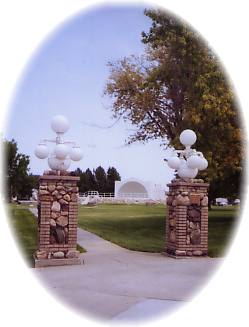
This site features a memorial to the Cheyenne Indian survivors of the Sand Creek Massacre on November 29, 1864. Created by a local historian and metal sculptor, Tobe Zweygardt, a teepee is guarded by an Indian brave astride his horse atop a nearby bluff. A brochure is available.
Cherry Creek Encampment a memorial to the Cheyenne Indians who survived the Sand Creek Massacre
Following the massacre of the Cheyenne Indians at Sand Creek on November 29, 1864, near the town of Chivington, Colorado, survivors made their way to a camp on the Smoky River.
The Cheyenne were so angry about the atrocities committed against their people that they sent around the war pipe at once. The pipe was taken to Spotted Tail and Pawnee Killer's Sioux, the Cheyenne Dog soldiers, and the Northern Arapahos. In response, all of these tribes moved and camped on Cherry Creek. It is written that nearly 3,000 Indians gathered here.
On New Years Day, 1865, the chiefs assembled in council and decided to attack Old Julesburg on the South Platte. From Cherry Creek, they set out, nearly 1,000 strong, to seek revenge and plunder the town where the Stage Company had a large station.
On January 7, 1865, the Indians attacked. After their successful coup, they loaded the plunder on their horses and in three days were back in the Cherry Creek encampment.
The Cheyenne, who had been mourning the great loss of their people at Sand Creek, took heart when their warriors returned with the goods they desperately needed. The camp on Cherry Creek was a scene of great feasting. Scalp dances were held and the young people danced until sunrise.
Meanwhile, the chiefs again gathered in council and decided to move north to the Black Hills to join the Northern Cheyenne, Sioux and Arapaho, and ask them to join in the war against the whites. It was from this historical site on Cherry Creek that the runners were sent to notify the tribes that they were coming, and criers announced the plans in all camps.
This is where the Plains War between the Indians and Whites began; a war that lasted twelve years and culminated at the Battle of the Little Big Horn in Montana in 1876.
On September 9, 1990, a dedication ceremony, in honor of the Cheyenne Indian survivors of the Sand Creek massacre, was held at this site. Descendants of those survivors, Cleo Wilson, son John Sipes and family, participated in the dedication. Cleo cried as she looked on the site, remembering the sufferings of her people as was passed down through the oral history from her elders.
About the Sculptor... Tobe Zweygardt, county historian and metal sculptor was born in Cheyenne County in 1916 of Volga German decent. As a youth, Tobe spent many hours hunting and trapping along the Cherry Creek. It was during those hours that Tobe became enthralled with the Indian history as he discovered Indian Artifacts. A farmer and welder by trade, Tobe began sculpting as a adult, using barb wire and discarded metal in his creations. A farm accident took four fingers from his left hand. Amazingly, Tobe does his art with only six fingers. Other sculptures of Tobe's in the county are: Ron Evins Memorial at the Cheyenne County Museum, wheat stalks on the Welcome to St. Francis sign and the Round Hole Campsite north of Bird City. Or stop by Tobe's home on the west edge of St. Francis and visit "The Barn" and view his many creations.